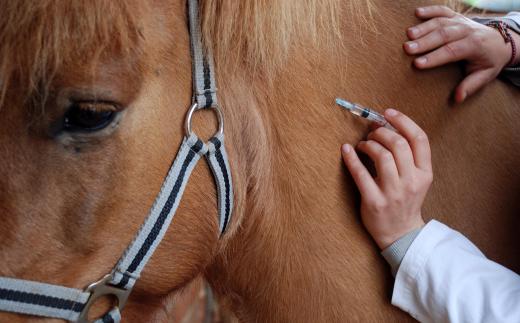Neorickettsia risticii (N. risticii), also known as equine monocytic ehrlichiosis, is a bacteria that causes Potomac horse fever when ingested. It attacks the gastrointestinal tract and causes a wide range of symptoms — specifically, high fever, sweating, projectile diarrhea, acute colic, colitis (inflammation), dehydration, loss of appetite, and depression. In the worst cases, laminitis and founder of all four hooves has been reported. Pregnant mares have also been known to abort. Edemas (swellings) of legs and body have been reported due to a protein imbalance that occurs.
Potomac horse fever gained national attention in the US during a sudden outbreak in the summer of 1979. This initial outbreak was in the Potomac River basin, northwest of Washington, DC, and of the nearly 100 horses that fell ill, a third of them died. The illness was quickly recognized in at least 32 other states. Considerable research was done, but it wasn’t until 1984 that the first breakthrough was made and the N. risticii bacterium was isolated in the blood of an infected pony. Researchers next focused on the vector of the disease, and after eliminating several insects, such as ticks, it was suspected that birds, bats, and flying insects were the carriers.

In 1998, the chief vectors were established as caddisflies, mayflies, dragonflies, damselflies, and stoneflies. These flies are recognizable for their moth or butterfly shapes and transparent wings. It also became apparent that horses at higher risk of the disease were those located near rivers, lakes, or large bodies of water. Through various stages of development, a flatworm called trematode carries the N. risticii organism through fresh water snails, insect larvae, and adult aquatic insects.

Horses can become infected by drinking directly from infected water or by ingesting adult flying insects. Horses who ingest as few as five infected insects, live or dead, can contract the bacteria. The sheer numbers of mayflies during the late summer and early fall months could easily allow for accidental ingestion in their forage or grain.
The first vaccine for this illness was approved in 1988, but it has not been found to be very effective in preventing the disease. It does, however, reduce the severity of the symptoms. It is important for horse owners and caretakers to follow up the first vaccination by a repeat booster within two to four weeks. Then an annual vaccination is a worthwhile safeguard for horses living in regions near water.

Diagnostic testing of Potomac horse fever takes two to three days. Samples for blood or fecal testing must be gathered before antibiotics are given. Vaccine antibodies can also interfere with the test results. People who suspect that a horse might be infected should isolate the animal immediately. Electrolytes can be given to help with the dehydration that can occur quickly.

There are a number of preventative measures that will help keep thid disease from infecting a barn. The most important is to prevent horses from drinking from natural water sources like ponds and streams. Water buckets must be kept clean and free from dead insects. Night lighting attracts mayflies and other vector insects, so lights should not be left on, especially during July and August evenings when aquatic insects are more common. It is also best for riders not to ride in outdoor arenas at night during this period. All hay and grain that is exposed to lighted areas should be covered, and it should be inspected before being fed to any horse.
Potomac horse fever is most contagious in late summer through early fall when the mayflies and other species are at their peak. The most successful treatement seems to be a combination of tetracycline and banamine, given intravenously for three days. This disease is not a diagnosis to be taken lightly; however, it no longer carries the high risk of fatality that it once did.
